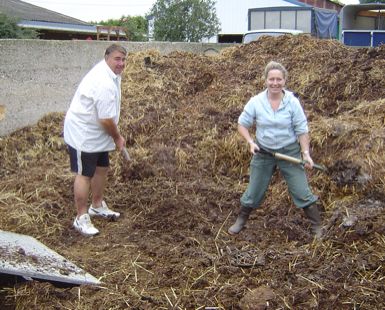
Foraging – Part 3. Perhaps today’s photo isn’t quite such an attractive image as the last blog’s revolving recycled radiator but is sure to bring a smile to Alan and Bernie. Voila! Alan, our fellow-foraging friend and Gabrielle, uh, how shall I put it delicately, shovelling shit! After the aforementioned trip to the tip to dump the slates from half of our barn roof—and the simultaneous recovery of the washing machine drum—before disconnecting Alan’s trailer, we headed down to the local stables where, by prior arrangement, we loaded up with horse manure, excellent nutritious organic soil improver, and completely free! We did two trips, one for Alan’s and Carol’s vegetable plot and one for ours.
One aspect of permaculture is to consider the inputs and outputs of each aspect of a designed system, so that outputs of one component, e.g., poultry pooh from the chicken house, becomes a valuable input for the garden via the compost heap rather than a pollutant, which needs to be got rid of—possibly with a disposal cost on top—as happens with large scale chicken farms. What we’ve done here is simply to obtain a local resource freely, whilst simultaneously helping the stables to dispose of an unwanted product. With so many people growing vegetables locally, it amazed me that there was plenty available and that we didn’t have to pay for it, as happens in the posher parts of the south of England!
Bearing all this in mind, I was inspired by Mark Fisher’s article (in issue 48 of Permaculture Magazine) on his innovative permaculture design at the Ecology Building Society’s new headquarters. Excavating and cultivating the site to create his new design, he unearthed all manner of junk and then had decisions to make on how to dispose of it. He wanted to assume responsibility for this waste, so “Recycling where I could”, he says, “some had to go into the waste stream, but the tarmac, concrete and brick is neatly stacked and retained on site. I haven’t hidden it, but then I haven’t skipped it so that it ends up polluting somewhere else. With time, moss will grow over it and the structural vegetation will obscure its presence. And … some creatures will probably find habitat and refuge in it”. After an experiment to see if we could smash up the slates into small pieces without sharp edges, we decided to keep the second trailer-full of slates and store them here for future use constructing footpaths.
